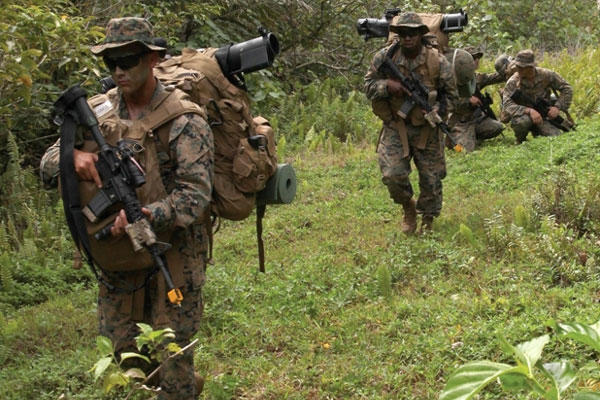The U.S. Marine Corps could enjoy its first plus-up of troops in several years if a provision in the new defense budget bill survives passage.
The draft version of the fiscal 2017 National Defense Authorization Act prepared by House Armed Services Committee Chairman Mac Thornberry would provide funding for 3,000 more troops than were asked for in the president's budget request.
The additional troops would bring the Marine Corps back to a pre-war end strength of 185,000, up from its planned steady state of 182,000.
Thornberry, a Republican from Texas, said he sought to meet the needs of the services in marking up his version of the bill.
"For both the Marines and the Air Force, I think a small increase in end strength was on their unfunded requirements list," Thornberry told reporters April 21, as the mark-up process was ongoing. "I take seriously, and I think they take seriously, these unfunded requirements lists."
Each service submits a "wish list" to Congress of items not budgeted for in the president's request.
A copy of the Marine Corps' unfunded priorities list, submitted to Congress in mid-February and obtained by Military.com, does not specifically request additional Marines. It does, however, ask for an additional $75.6 million in personnel funding for selective re-enlistment bonuses, as well as foreign language proficiency bonus pay and permanent change of station funding.
Marine Corps leaders have been adamant about the dangers of drawing down too far while continuing to deploy in support of the fight against the Islamic State and to other areas around the globe. Marine Corps Commandant Gen. Robert Neller has also spoken publicly about his interest in increasing the Marines' young community of cyber and electronic warfare Marines.
In a February lecture at the Atlantic Council, Neller said the Corps faced two options: ask for an end strength increase after whittling ranks to meet budget constraints, or restructure the existing forces to confront the new mission. He said the service might have to cut from the operational forces and infantry community to allow these new specialties to grow.
"I'm willing to take risk in the units we have now," he said. "Once we determine what are the capabilities we need and what are the types of Marines we need to do that, you know, those are not going to be [privates first class] and lance corporals over time."
The commander of Marine Corps Combat Development Command, Lt. Gen. Robert Walsh, outlined the service's need even more clearly in a lecture at the Center for Strategic and International Studies at the end of March.
The Marine Corps, he said, needed to grow cyber, EW, and information warfare by 1,000 to 3,000 troops above the roughly 1,500 already serving in the community.
"We're going to have to trade capabilities within the [Marine air-ground task force] to be able to grow those capabilities," he said. "We're going to grow in that area of Marines; that is going to have to come from within the force to be able to make this a more capable 21st century force."
Generals have also discussed their desire to put more space between deployments for Marines, allowing them to stay home more than twice as long as they spend deployed. More troops would allow the Corps to positively adjust this deployment-to-dwell ratio.
Thornberry opted to move $18 billion earmarked for overseas operations in the president's budget request to the base budget to pay for procurement and maintenance, as well as the Marine Corps troop plus-up. This would leave operations including the fight against Islamic State militants funded only until the middle of next year, forcing the next president to push additional funding through Congress shortly after taking office.
The budget bill has to pass several hurdles before the Corps can start planning for additional manpower. Currently in its draft form, the NDAA will undergo a committee-wide markup within the House Armed Services Committee on Wednesday. It then must be passed by both the House and the Senate. President Barack Obama could also choose to veto the bill after passage.
-- Hope Hodge Seck can be reached at hope.seck@military.com. Follow her on Twitter at @HopeSeck.
Related video:

























